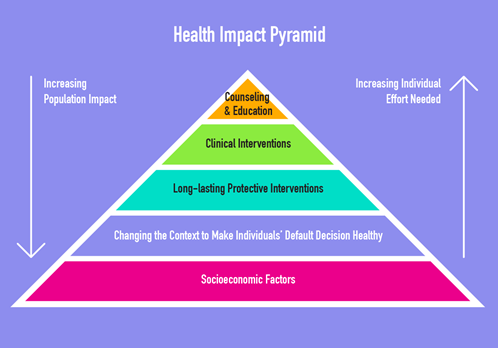Online Course
NURS 418 WB - A Public Health Approach to Violence Prevention
Module 4: Interpersonal Violence: Youth and Community Violence
Youth violence
The WHO World report on violence and health defines youth violence as violence among individuals aged 10–29 years who are unrelated and who may or may not know each other, and generally takes place outside of the home. Examples of youth violence include bullying, physical assault with or without a weapon, and gang violence. High rates of perpetration and victimization often extend to the 30–35 years age band, and this group should be taken into account when trying to understand and prevent youth violence.
From Youth Violence (CDC, 2018): “Youth violence is preventable. The ultimate goal is to stop youth violence before it starts.” https://www.cdc.gov/violenceprevention/youthviolence/index.html
For the magnitude of youth violence, think of a pyramid, with violent deaths only the top.

Figure 2. Health Impact Pyramid. Prevent Violence NC (2015). http://cindywaitt.com/wp-content/uploads/2013/08/PYRAMID-BULLYING-CORRECTED2.png
Next, are victims that come to the attention of health, legal, other authorities. The base, and much broader layer of the pyramid, includes acts of youth violence (e.g. bullying) that may never be reported. Not all victims of violence are willing to disclose experiences even in a confidential interview, so the base of the pyramid also comprises the many victims of youth violence who suffer in silence. Therefore, regular population-based surveys are must be supported to document the prevalence and consequences of youth violence.
Youth Violence Prevention: What works?
Interventions for addressing youth violence can be grouped into four categories: 1) community and society level interventions include laws, policies, and funding priorities 2) parenting and early childhood development; 3) school-based academic and social skills development; 4) interventions among young people at higher risk of or already involved in violence.

Figure 2 https://preventviolencenc.org/health-impact-pyramid
The evidence on interventions to prevent youth violence is unevenly distributed over different ecological levels. The largest proportion of interventions and outcome evaluation studies concern strategies that address risk factors at the individual and close relationship levels (the top of the pyramid). Far fewer community- and society-level interventions (bottom of pyramid) have been implemented or evaluated. This is unfortunate as community- and society-level strategies can be evaluated for their effects on direct measures of youth violence, such as rates of homicide and non-fatal, assault-related injuries treated by emergency departments, self-reported victimization and perpetration.
Take home Messages
- Youth violence occurs among 10-29 y/o, generally takes place outside the home.
- YV is one of the leading causes of death worldwide, contributing to decreased life expectancy in the U.S. in these age groups.
- The more risk factors that accumulate (for an individual or a particular setting), the greater the likelihood that the individual /setting will experience or become involved in violence.
- There are programs that we know work- widespread implementation is needed.
- Much more evaluation and more efforts are needed to prevent youth violence- especially at the community/environmental level.
This website is maintained by the University of Maryland School of Nursing (UMSON) Office of Learning Technologies. The UMSON logo and all other contents of this website are the sole property of UMSON and may not be used for any purpose without prior written consent. Links to other websites do not constitute or imply an endorsement of those sites, their content, or their products and services. Please send comments, corrections, and link improvements to online@son.umaryland.edu.